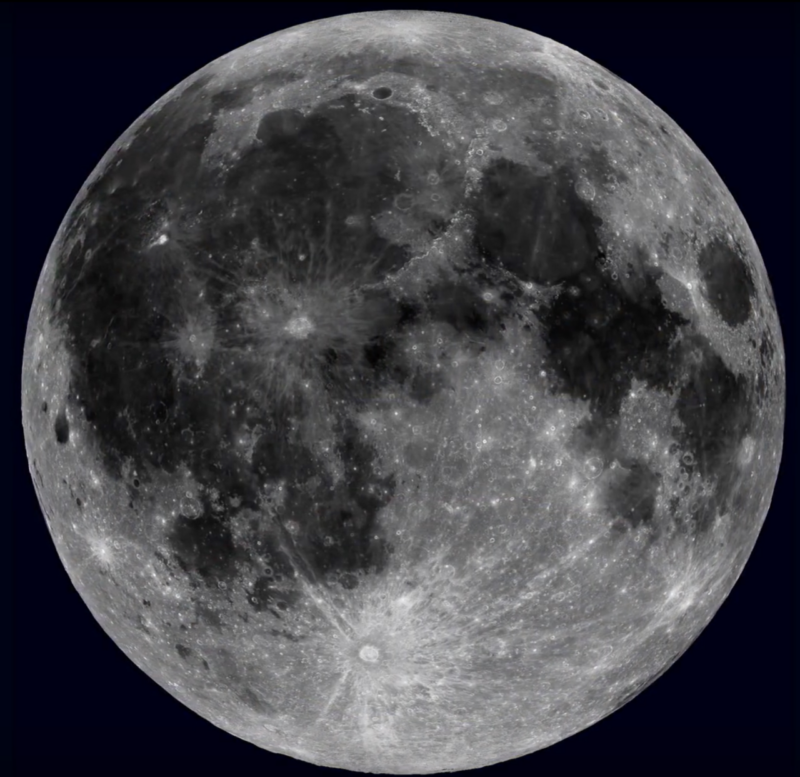Our Moon may appear to shine peacefully in the night sky, but billions of years ago, it was given a facial by volcanic turmoil.
One question that has gone unanswered for decades is why there are more titanium-rich volcanic rocks, such as ilmenite, on the near side as opposed to the far side. Now a team of researchers at Arizona Lunar and Planetary Laboratory are proposing a possible explanation for that.
The lunar surface was once flooded by a bubbling magma ocean, and after the magma ocean had hardened, there was an enormous impact on the far side. Heat from this impact spread to the near side and made the crust unstable, causing sheets of heavier and denser minerals on the surface to gradually sink deep into the mantle. These melted again and were belched out by volcanoes. Lava from these eruptions (more of which happened on the near side) ended up in what are now titanium-rich flows of volcanic rock. In other words, the Moon’s old face vanished, only to resurface.
What lies beneath
The region of the Moon in question is known as the Procellarum KREEP Terrane (PKT). KREEP signifies high concentrations of potassium (K), rare earth elements (REE), and phosphorus (P). This is also where ilmenite-rich basalts are found. Both KREEP and the basalts are thought to have first formed when the Moon was cooling from its magma ocean phase. But the region stayed hot, as KREEP also contains high levels of radioactive uranium and thorium.
“The PKT region… represents the most volcanically active region on the Moon as a natural result of the high abundances of heat-producing elements,” the researchers said in a study recently published in Nature Geoscience.
Why is this region located on the near side, while the far side is lacking in KREEP and ilmenite-rich basalts? There was one existing hypothesis that caught the researchers’ attention: it proposed that after the magma ocean hardened on the near side, sheets of these KREEP minerals were too heavy to stay on the surface. They began to sink into the mantle and down to the border between the mantle and core. As they sank, these mineral sheets were thought to have left behind trace amounts of material throughout the mantle.
If the hypothesis was accurate, this would mean there should be traces of minerals from the hardened KREEP magma crust in sheet-like configurations beneath the lunar surface, which could reach all the way down to the edge of the core-mantle boundary.
How could that be tested? Gravity data from the GRAIL (Gravity Recovery and Interior Laboratory) mission to the Moon possibly had the answer. It would allow them to detect gravitational anomalies caused by the higher density of the KREEP rock compared to surrounding materials.
Coming to the surface
GRAIL data had previously revealed that there was a pattern of subsurface gravitational anomalies in the PKT region. This appeared similar to the pattern that the sheets of volcanic rock were predicted to have made as they sank, which is why the research team decided to run a computer simulation of sinking KREEP to see how well the hypothesis matched up with the GRAIL findings.
Sure enough, the simulation ended up forming just about the same pattern as the anomalies GRAIL found. The polygonal pattern seen in both the simulations and GRAIL data most likely means that traces of heavier KREEP and ilmenite-rich basalt layers were left behind beneath the surface as those layers sank due to their density, and GRAIL detected their residue due to their greater gravitational pull. GRAIL also suggested there were many lesser anomalies in the PKT region, which makes sense considering that a large part of the crust is made of volcanic rocks thought to have sunk and left behind residue before they melted and surfaced again through eruptions.
We now also have an idea of when this phenomenon occurred. Because there are impact basins that dated to around 4.22 billion years ago (not to be confused with the earlier far-side impact), but the magma ocean is thought to have hardened before that, the researchers think that the crust also began to sink before that time.
“The PKT border anomalies provide the most direct physical evidence for the nature of the post-magma ocean… mantle overturn and sinking of ilmenite into the deep interior,” the team said in the same study.
This is just one more bit of information regarding how the Moon evolved and why it is so uneven. The near side once raged with lava that is now volcanic rock, much of which exists in flows called mare (which translates to “sea” in Latin). Most of this volcanic rock, especially in the PKT region, contains rare earth elements.
We can only confirm that there really are traces of ancient crust inside the Moon by the collection of actual lunar material far beneath the surface. When Artemis astronauts are finally able to gather samples of volcanic material from the Moon in situ, who knows what will come to the surface?
Nature Geoscience, 2024. DOI: 10.1038/s41561-024-01408-2



3175x175(CURRENT).thumb.jpg.b05acc060982b36f5891ba728e6d953c.jpg)

Recommended Comments
There are no comments to display.
Join the conversation
You can post now and register later. If you have an account, sign in now to post with your account.
Note: Your post will require moderator approval before it will be visible.